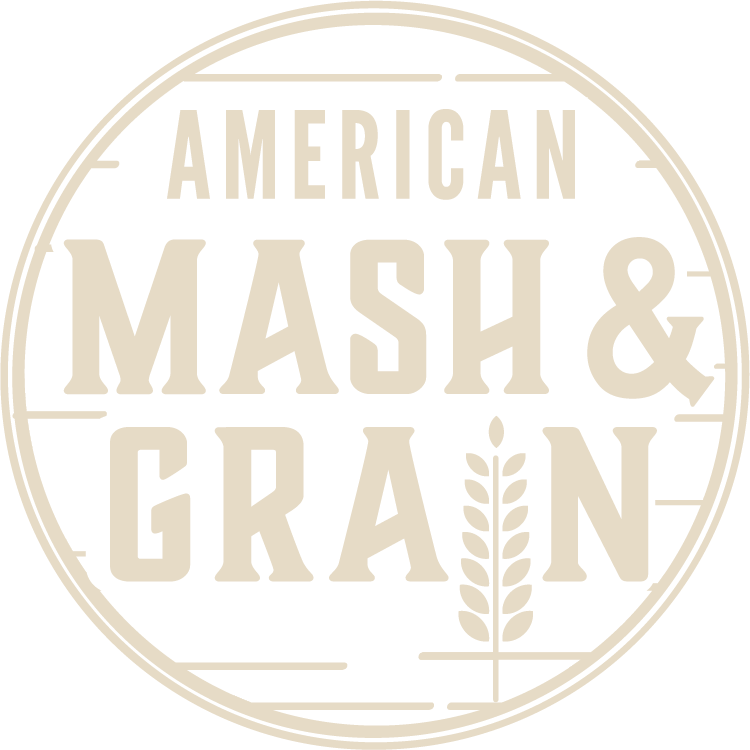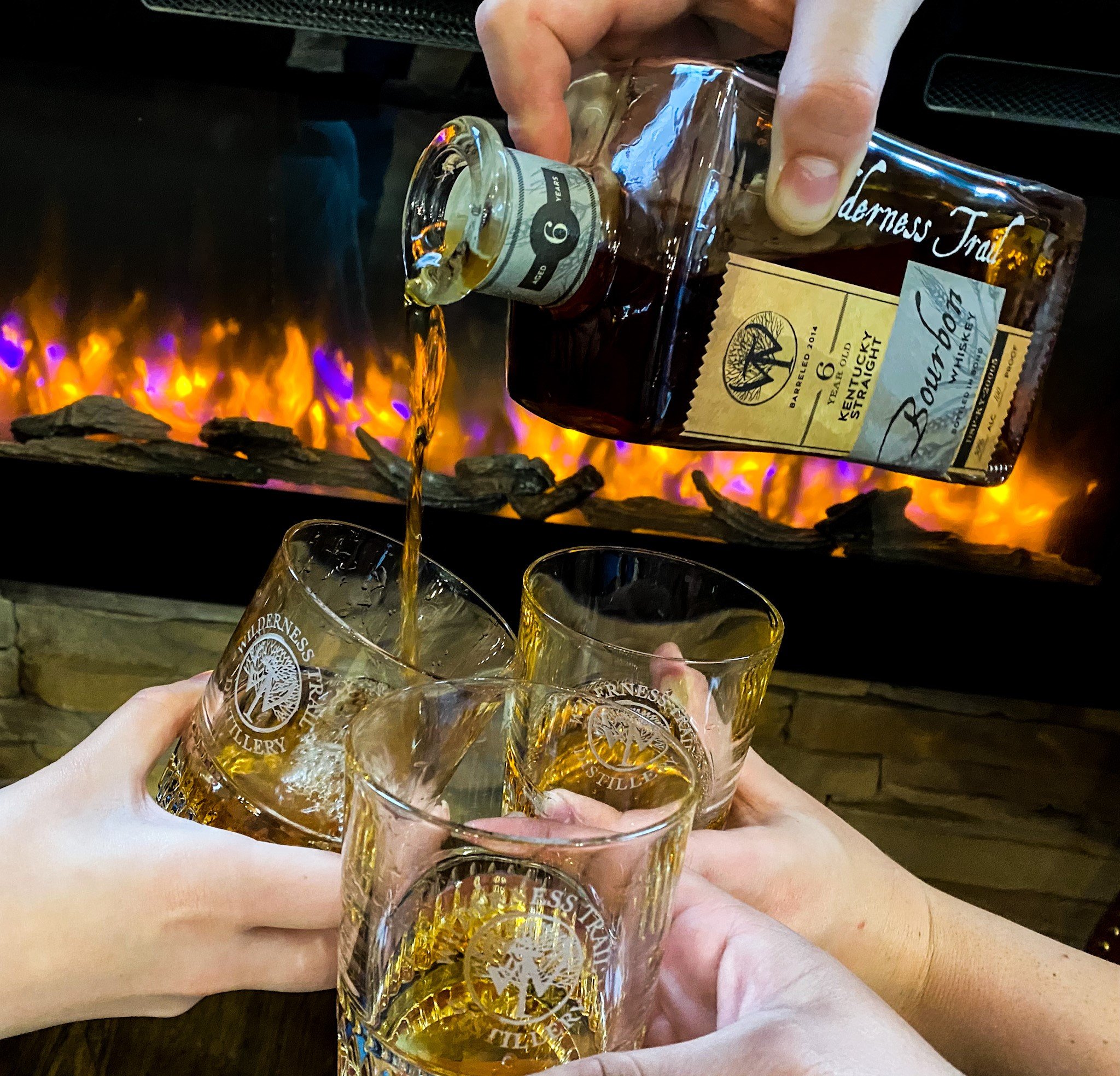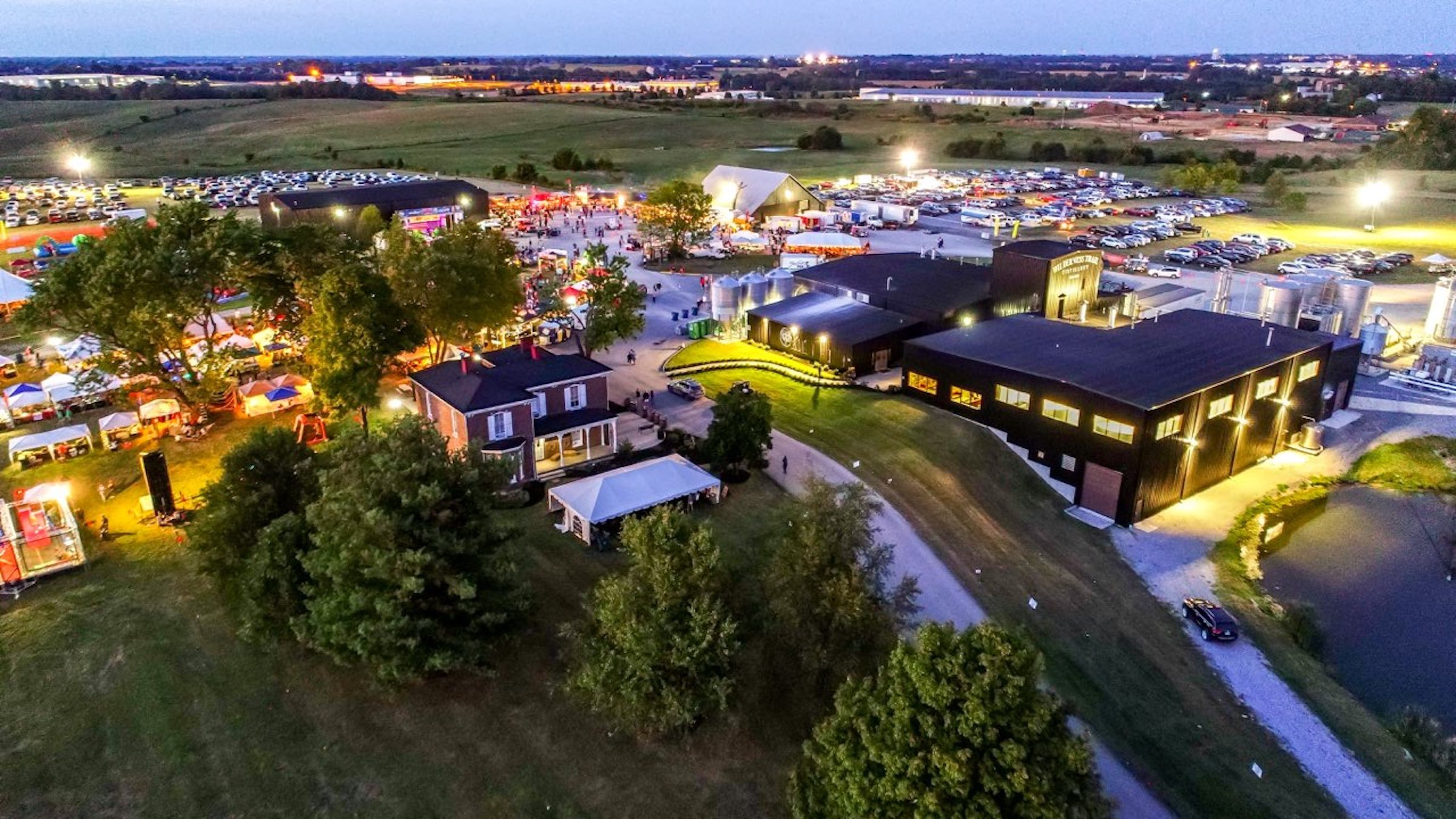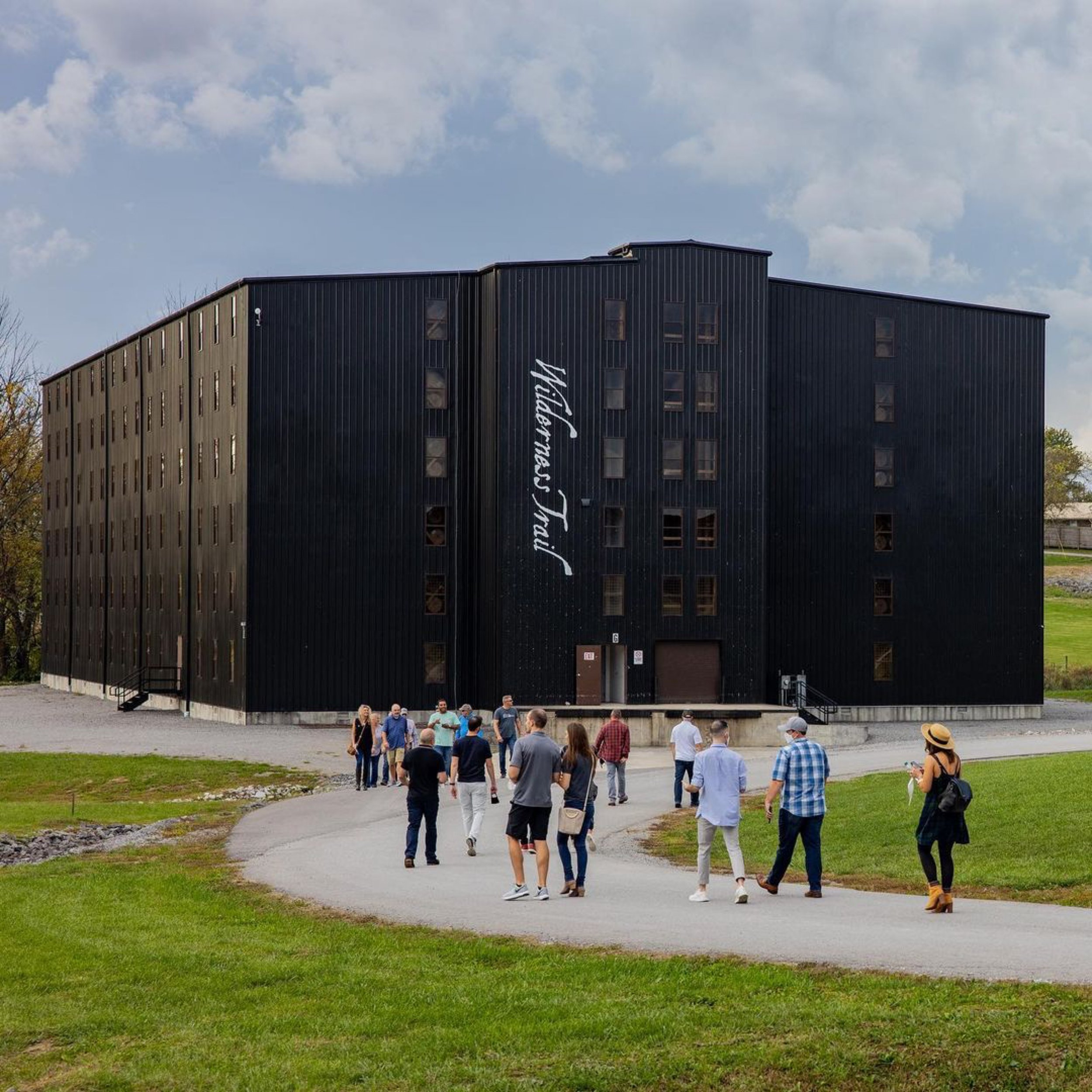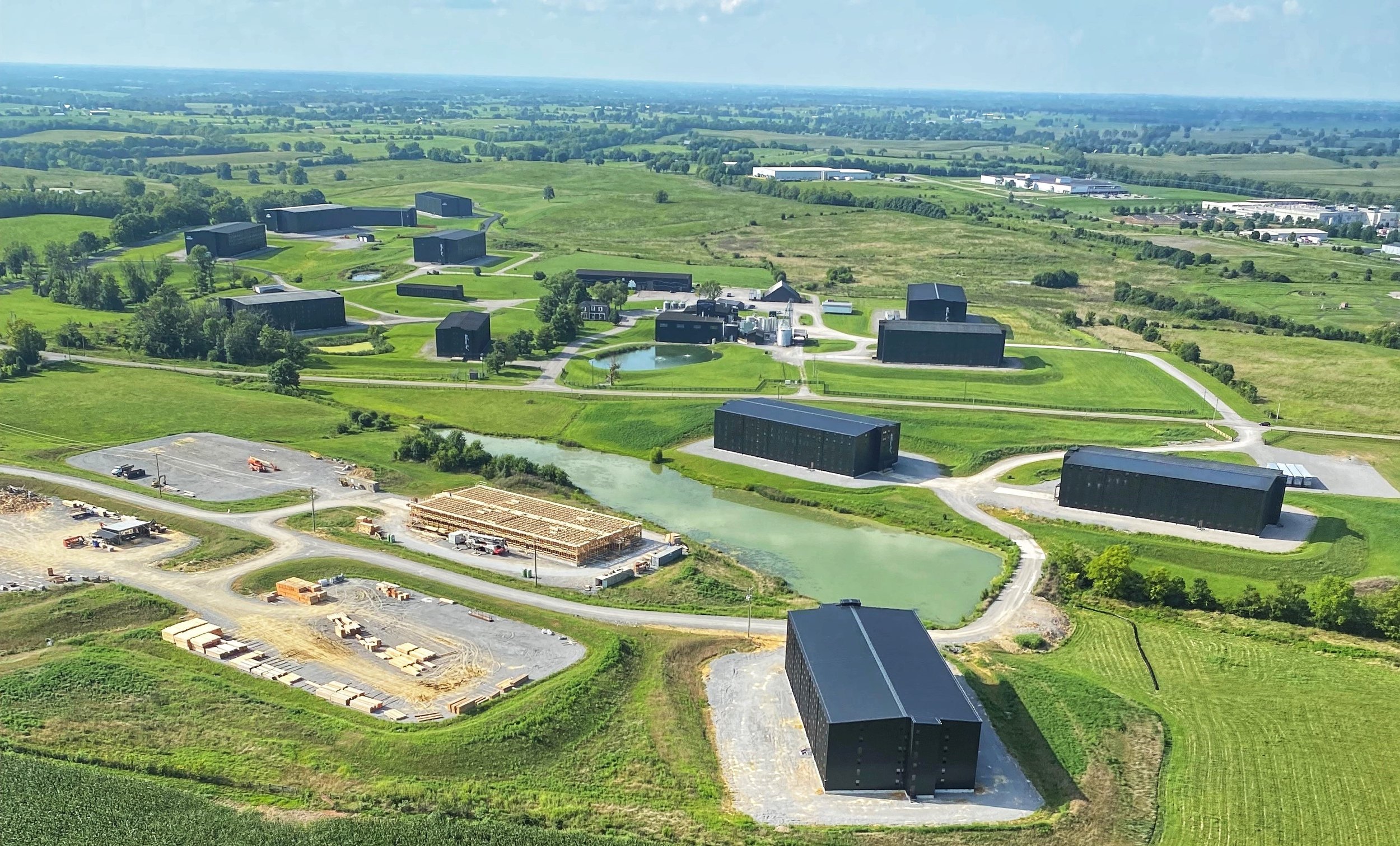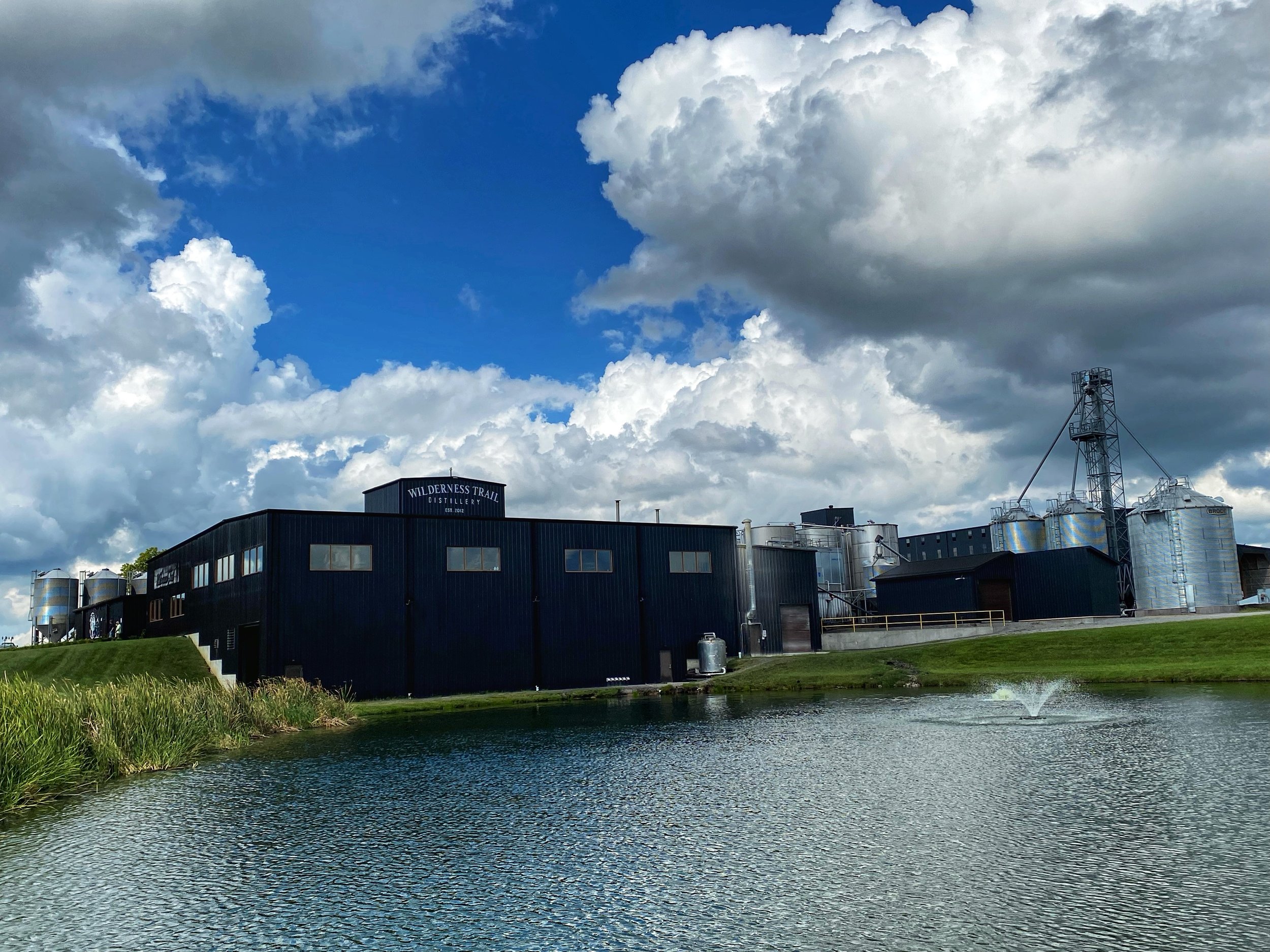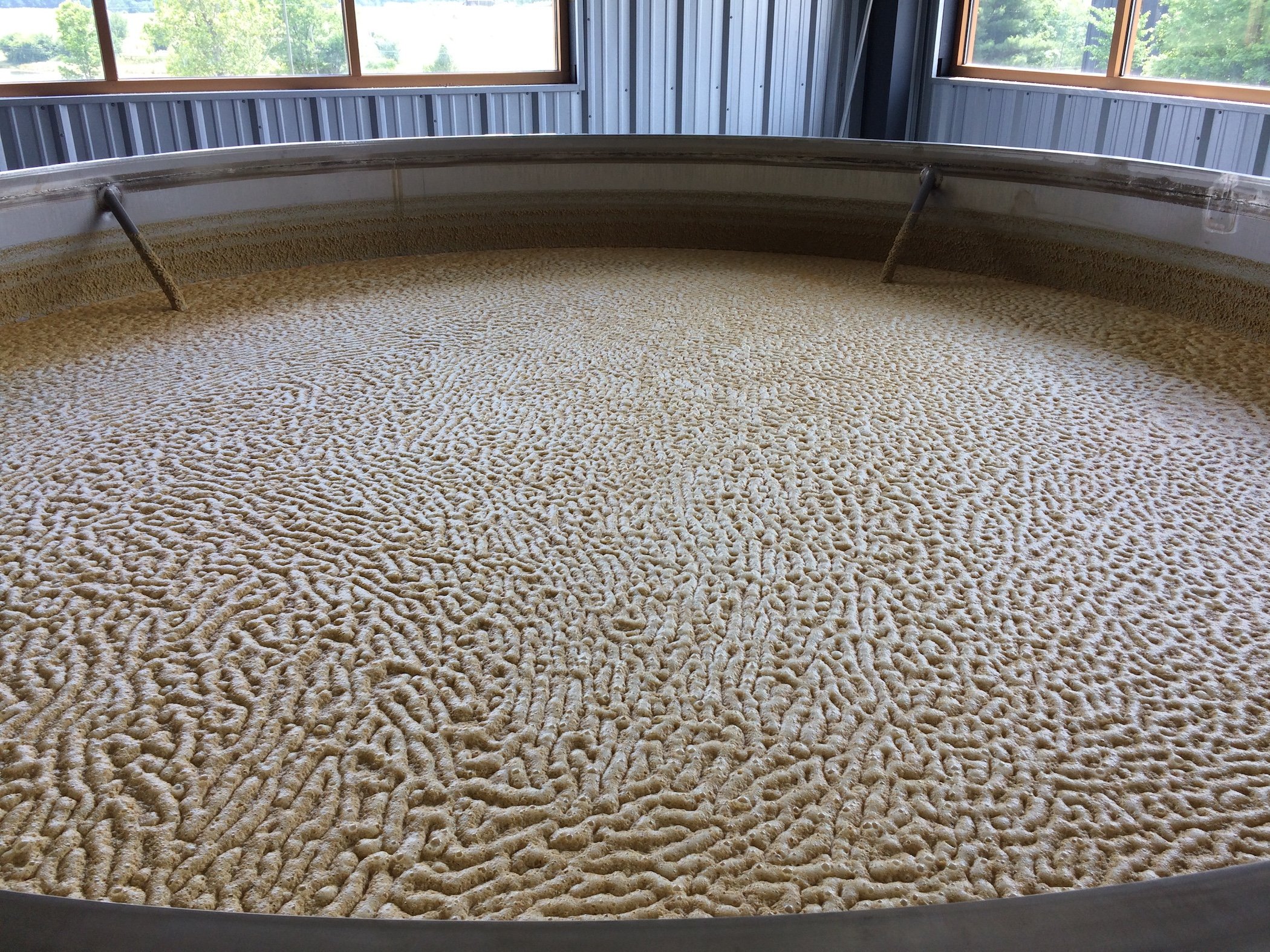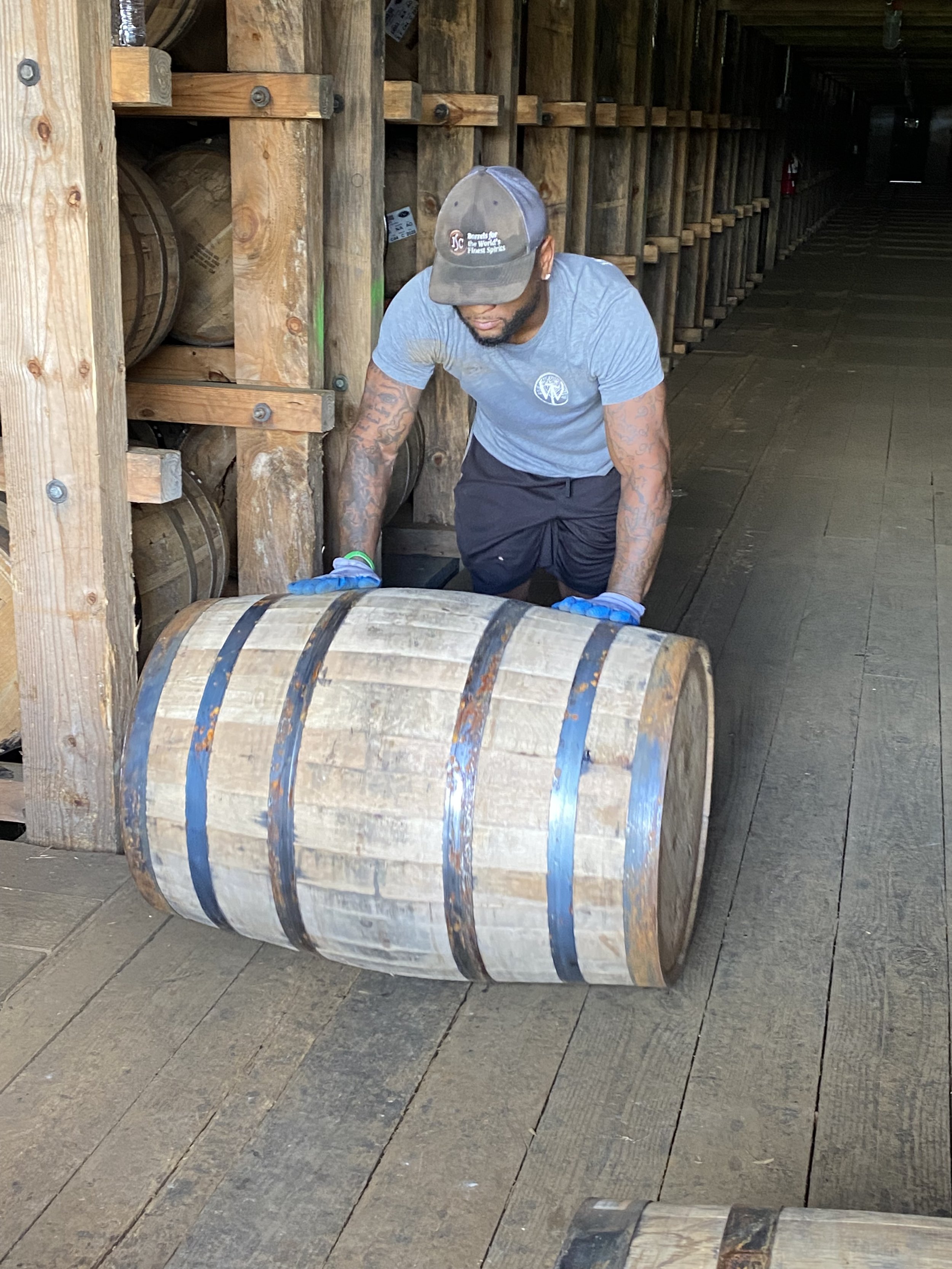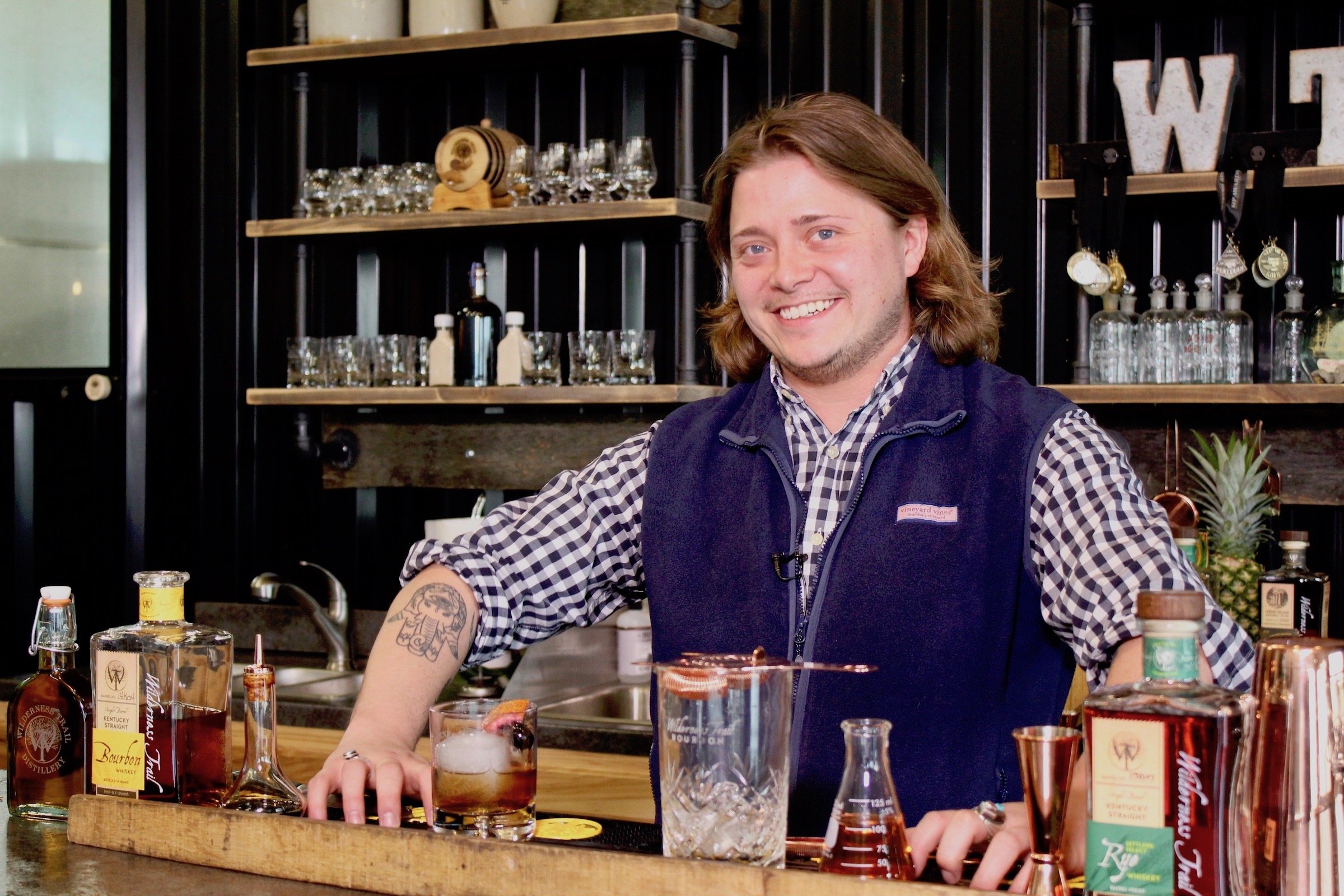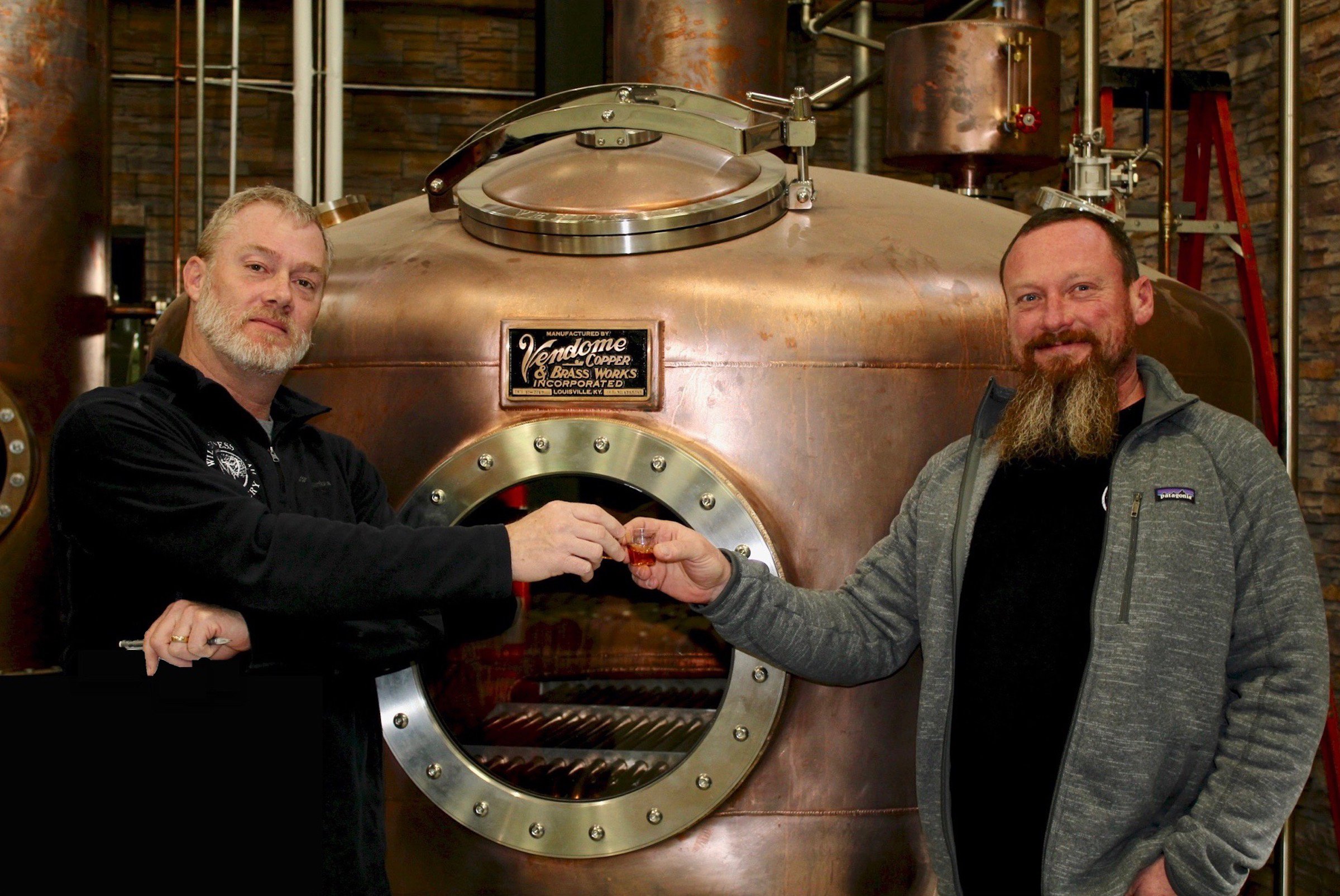Wilderness Trail Distillery
By Meghan Swanson
Microbes, microphones, and mash–sweet mash, that is. Where do these things intersect? In the dreams that Wilderness Trail Distillery founders Pat Heist and Shane Baker have wrestled into reality together. Thanks to a mix of hard work, visionary thinking, and a lucky tendency to pounce on the right opportunity at the right time, the two Kentuckians have traveled a long road that has led them to their own wildly successful distillery experiment. From friends to bandmates to business partners and finally, distillery co-founders, Shane and Pat have walked their own path, defying industry norms and never accepting the status quo. Once you get to know them, their tale doesn’t seem as fantastic as it does on the surface; after all, with Shane and Pat, you just have to learn to expect the unexpected.
“We got credit cards, let’s max ‘em out. Let’s rock. And that’s exactly what the hell we did.” - Shane Baker
Shane Baker and Pat Heist have known each other for twenty years. “Our families grew up together, and that bond has been just unbreakable since.” Shane explains. In the late 1990s, they played rock n’ roll together in a band called Fulcrum. “The engineers won the vote on the name,” Pat points out wryly. Oh, and one more thing–these whiskey-making rock musicians are both accomplished scientists. Shane is an engineer; Pat, a microbiologist.
“Microbiology is my thing…I’ve been in a few different areas of microbiology; from microorganisms that affect field crops in agricultural settings, I’ve been a professor of medical microbiology, so human microbiology…that’s kind of what led to the first company Shane and I started, which is called Ferm Solutions.” Pat says. Ferm Solutions markets yeast for distillation and brewing, provides enzymes for beverage alcohol distillation, and offers laboratory services for the fermentation process. By 2006, the band had dissolved. Shane was working in capital ventures and had lived in six states in the preceding four years; his young children were getting ready to enter kindergarten, and his wife was ready to settle down. Pat had just finished his Ph. D and was looking ahead to the next steps in his career. “I just remember coming together and talking about the daily grind and what we were going through...it just came quickly…why aren’t we doing something? We’re working hard for everyone else and we’re doing a really good job.” recalls Shane. This was the moment Ferm Solutions was born - the two friends maxed out those credit cards and hit the throttle, throwing everything they had behind their new venture.
It is said that success happens when preparation meets opportunity; Pat and Shane leapt after their new opportunity in Ferm Solutions with plenty of preparation. Together they came up with an incredibly detailed, complete business plan and launched their efforts accordingly. They were also blessed with excellent timing, coming into a market hungry for help with distillation. “We like to think we’re always ahead of the curve; for some fortuitous reason, we often are.” Shane explains with a mildly bemused expression. In the early 00s, the majority of companies looking for Shane and Pat’s expertise weren’t making whiskey, or indeed any drinkable spirit; they were making fuel alcohol. A federal ban had just come down on a certain harmful oxygenate used in gasoline, suddenly spiking demand for ethanol as its replacement. Fuel alcohol was the ‘roaring gorilla’ at the time, says Pat, while beverage alcohol was still a sleeping giant.
The decision to start Ferm Solutions when they did was not random; Pat had done some work with fuel alcohol already, and Shane had an interest in biodiesel. They found themselves riding a rocketship, figuratively, while literally racking up the miles in Shane’s 1992 Maxima. They spent probably 24 days out of the month living out of that car, Shane recalls–Pat interjects with a laugh that his own car wasn’t even functional enough to do the job–sharing hotel beds or sleeping at rest stops when they weren’t driving. All that ‘windshield time’, as he calls it, was spent cooking up their next dream. Ferm Solutions quickly became one of the fastest-growing companies in the industry at the time, with Shane and Pat providing help to distillation outfits all over the globe. “Within no time, we’re finding ourselves with a highly successful company, great branded products, and the next opportunity for us was to jump into what we wanted to do in the beginning…making our own whiskey.” Shane tells us.
“We’re some of the biggest bourbon fans on the planet. We were bourbon fans before we even thought about Wilderness Trail.” -Pat Heist
Pat and Shane are both, obviously, huge bourbon aficionados. Shane, however, has a uniquely personal connection to bourbon. “I wouldn’t even be here if it wasn’t for whiskey, okay? My pure existence would not be here if it wasn’t for Kentucky bourbon.” he declares. “As that story goes, it’s not a back-of-the-car story; my parents don’t even drink.” He clarifies with a raised brow. He means his existence, and that of his family trees, in a larger sense. “My grandmother met my grandfather at Kentucky River Distillery. Obviously, the rest is history.” he recounts with a soft smile.
In addition to providing the setting for his grandparents’ budding romance, the bourbon industry also provided his grandmother with a career in distilling spanning more than 50 years. “I grew up in this industry, definitely grew up a bourbon drinker–beer wasn’t the first thing on my list, I only had access to whiskey.” Shane laughs. In fact, during legendary family Christmas gatherings at Grandma’s house in Louisville, he unknowingly had access to some unique and rare bourbon. His grandmother–who, like his parents, didn’t drink–collected novelty decanters of whiskey over the years. Limited runs, special holiday offerings, you name it; it was probably in a fanciful decanter set displayed on the shelves in her basement. During the large extended family’s often chaotic holidays, the grandchildren usually ended up shunted off to the basement to play. And play they did - the older adolescents, over the years, steamed the seals off all those decanters, taking a nip here and there until they refilled the decanter with water and replaced the seal–and then on to the next. No one was the wiser for decades, until Grandma’s passing, when these ‘heirlooms’ were divided out among the siblings. You can imagine the dismay at finding the supposed rare and highly valuable bottle of bourbon you just inherited turning out to be tap water from the 1970s. There is one uncle, Shane says, who still doesn’t speak to him and his cousins.
“One of the reasons we started the distillery–probably the biggest reason–is we just love the industry.” Pat explains. While they were riding that figurative rocketship driven by fuel alcohol, they were also getting to know brewing and beverage alcohol distilling on an intimate level. “Yeast gets the blame for every problem a distillery or a brewery or whatever [has], because the fermenter’s not bubblin’ right and you’re calling the yeast guy.” Pat says. “We’ve been in and out of hundreds, if not over a thousand, distilleries and breweries and we have yet to be invited to a distillery when everything is going great and just have a drink on the porch.” he laughs. Over the years, they became experts at troubleshooting in distilleries and breweries. “It’s a two-way street. The distillery plays into the fermentation business, the fermentation plays into the distillery.” Pat explains. Yet none of their competitors in the fermentation had–or have–their own distilleries. This made no sense to Pat and Shane - used to thinking outside the box, the way forward seemed clear to them. “We had a successful company in Ferm Solutions that was generating good capital, here we are taking phone calls from some of the most famous master distillers in the world, helping them with all their problems…it [was] just kind of like, shit, man, we need to have our own distillery!” Pat exclaims.
“I remember when we got our first iteration of Wilderness Trail: our pot stills, our fermenters…it really seemed big.” -Pat Heist
Wilderness Trail Distillery’s first physical location was in downtown Danville, Kentucky. Pat and Shane built their new distillery onto an existing Ferm Solutions warehouse in 2012. “We’re in historic Danville, Kentucky–it’s a city of the ‘firsts’. The constitution of Kentucky was written there, the first appendectomy surgery was done there, the first post office was in our town ([first post office] west of the Allegheny mountains)...it just keeps going on, we got so much old shit in town it’s just crazy.” Shane recounts. They started out with a 300-gallon pot still from Vendome Copper & Brass Works, plus two rectification columns. “All Vendome equipment,” Shane stresses. “We only, exclusively, use Vendome. The best equipment in the world, the best family in the world to work with, and I simply wouldn’t want a drop of alcohol in anything else.” he states. They wanted that very first still to be able to make any kind of spirit; they knew well that aging whiskey properly takes time. “We knew while our whiskey was aging, we had to have something to kind of offer people when they came by.” Shane explains. Their Blue Heron Vodka fits the bill, having garnered platinum at the 2017 Spirits International Prestige (SIP) Awards, a 2017 San Francisco World Spirits Competition Gold Medal and an American Distilling Institute Gold Medal for Grain-to-Glass Vodka with a Neutral Character. That original still would yield about 2-3 barrels of spirit per day; that’s if they ran it all night.
It wasn’t too long thereafter that they upgraded to an 18-inch column still–again, of course, from Vendome. “That’s an 18-inch diameter column.” Pat interjects. Shane grins, running with the joke. “Actually, I’ve got it right here on my desk.” he quips, holding his hand out above his desk surface and miming an invisible, 18-inch high column still. Their second still would yield 36-45 barrels per day, running around the clock. “Still one of the best stills that we have running. I absolutely am just partial to that little still.” remarks Shane. These days, they run only wheated bourbon off of it, and though it makes just 15 thousand barrels per year, it’s still responsible for the majority of the wheated bourbon Wilderness Trail makes. In 2013, they added a 36-inch column still, which can make up to 200 barrels in a day. They had come a long way from their first little still, and as their confidence in their brand grew, so did the brand itself.
They had started out in downtown Danville in 2012, and once again, they found themselves facing the happy challenge of exponential growth. “Our original barrel warehouse that was supposed to be our ‘forever’ warehouse, we would fill it in ten days now instead of it taking nine years.” Pat marvels. After just a year and half, they were outgrowing the downtown space. They needed more room, but they were wise enough to make a point of working for sustainable growth. “We’re small business guys. We don’t want to leverage ourselves, we don’t want to get overloaded. We’ve never been in debt.” Shane points out. Looking for land to build on, Pat and Shane got together with the Danville-Boyle County Economic Development Partnership.
As a newer distillery, they were constrained by rules that the oldest distilleries in Kentucky aren’t subject to–those big guys are grandfathered in. Wilderness Trail couldn’t plop down in any old location. They would have to stay in the industrial park. Fortunately, the Economic Development Partnership (EDP) was willing to help. They worked with Wilderness Trail and helped them get set up with the perfect site on the western tip of the industrial park, still within Danville. Starting out with just 13 acres, they moved to their new land in 2014 and built their first rickhouse there. In 2015, the distillery itself moved to the property; they restored a stately brick Italianate manse–once home to the sisters credited with composing ‘Happy Birthday to You’--to serve as their offices onsite. By 2016, the distillery was up and running on the new site. Today, their site covers 163 acres (including the original 13), and they’ve got more acreage earmarked for them by the EDP–just in case.
“We’re scientists. Every step of this process, we’re looking at very scientifically.” -Pat Heist
The years spent on Ferm Solutions had left Pat and Shane with a very good idea of what they did and didn’t want to do with their own distillery. “Over the years, we’ve just become experts at troubleshooting in distilleries. We’ve seen every bad idea there is, we’ve seen every good idea there is.” Pat says. They looked at the traditional process of industrial distilling, and then ripped it all apart, refining every step. “The quality starts at the front of the process. Distillation, as sexy as it is, all it is is removing what we already created. And if you don’t create it right the first time, you are not gonna have shit coming out the back end. I don’t care how long you leave it in the barrel, it ain’t gonna be any better. It’s gotta be good going in, and it will get better coming out.” Shane explains. Quality, for them, begins with the grain. Lucky for Pat and Shane, they had one of the best seed farms in the state right in their backyard. “We’re local guys, we’re neighbors, we know each other. I need grain, you grow grain–this is gonna work out great.” Shane recalls. That began their relationship with Caverndale Farms, and established a consistency and quality of grain owing to the fact that they’re buying from a seed farm; seed grain tends to be cleaner and of a higher quality than other bulk grain. This suits the Wilderness Trail ethos just fine. “It’s right here in the community, we know where our money’s going. It’s new silos going up, it’s new tractors in the field, it’s new people out in the community with jobs. It just makes sense that’s where you want to invest.” Shane points out.
Wilderness Trail is also an entirely ‘clean-steam’ operation; a process in which they utilize low pressure steam so they can run soft water through their boilers. Most every other distillery runs a high pressure steam which requires chelating chemicals to reduce or eliminate mineral scale in the boiler. Their process is completely chemical-free. They cook their mash at a much lower temperature than most distilleries. Examining the process with a scientist’s eye, they found that starch gelatinizes at around 175 to 185 degrees Fahrenheit; most distilleries cook their mash at over 200 degrees Fahrenheit. Pat says one theory for this might be that recipes and methodology for these other distilleries is held over from times when distillers may not have had access to thermometers (for example, in a Prohibition-era illegal operation) and used more imprecise measures like the boiling point to tell them when the mash was hot enough. In Pat and Shane’s eyes, that’s using a lot of unnecessary energy. “There are a lot of considerations we’re making in this process. Sure, we want to make the best bottle of whiskey, we’re not gonna do anything to compromise that–but in the process, if we can save a million dollars a year on energy just by making a better decision, we’re gonna do that.” Pat explains.
When they were ripping apart and refining their distillation process, Shane and Pat came across the concept of a sweet mash in a 1974 article about Kentucky River Distillery, where Shane’s grandparents had met. It was previously the site of E.J. Curley Distillery, a distillery that had once supplied spirits to Civil War troops; the article claimed that E.J. Curley had had two distilleries on that site: one sour mash and one sweet. Wilderness Trail had unknowingly already skipped the very common sour mash process by starting with a completely fresh batch of mash for every fermentation; they didn’t include that back step of adding a portion of previously fermented mash to a new batch. Shane uncovered a Seagram’s production book that detailed the sweet mash method in highly scientific, peer-reviewed detail and pronounced it the best method to make the best-tasting whiskey. At the bottom was a note: the process was impossible to adapt for industrial distillation. “Sweet mash creates a superior whiskey: it’s just extremely hard to make. So we quickly realized, ‘Ok, we know why nobody makes it. Can we do it?’”. Shane wondered. If anyone can do it, we can, Pat replied - and they did.
“It comes back to the three Cs, if you will: creation is what we do in the cooker. When we’re in the fermentation, we’re in the control. When we take it through the still, the final C is closure.” Shane explains. “We’re cooking like a fine chef would make a good meal. The yeast are just doing their job, we’re just controlling the environment, and then we’re closing the deal out when it gets to the still.” he says, gliding one hand horizontally through the air to illustrate the smooth simplicity of the process. The sweet mash, in fact, contributes to the smooth quality of their bourbon. “You don’t get the big ‘Kentucky hug’ with our whiskeys, right? Part of that sweet mash is, it’s a higher Ph. We’re gonna get all scientific on you here. Acid reflux–sour mashes are sour, they’re lower Ph, it’s gonna come back up at you, you don’t like it. Ours is a little higher Ph because of how we ferment and that comes across in the distillate. You’re soaking it down, it’s just nothing but goodness.” Shane explains with a smile. “We would say it’s the Pepto Bismol of bourbon, but we don’t want to get that started.” jokes Pat.
“As the consumer, you should be able to look at our brand and be able to trust it like you do the surgeon who’s getting ready to save your life.” -Shane Baker
Wilderness Trail’s bottle features a wide-branching tree superimposed with the ‘W’ and ‘T’ that stand for the brand. This design, doodled by Shane during a conference call and later refined, stands for the distillery’s beginnings in problem-solving. Shane and Pat spent decades getting to ‘root cause’ for other distilleries, literally climbing into pipes underground in order to find where an issue started. “When we do tours, the first thing on our tour you’re gonna see is the laboratory of Ferm Solutions, because that’s the beginning of the story.” Pat says. They have never forgotten those roots, and still utilize the Ferm Solutions lab in Wilderness Trail’s operations. Distillation doesn’t happen in a vacuum; microbes get into product that weren’t put there intentionally, and Pat and Shane are experts on figuring out how that happens. “If our goal is to make a very consistent product, and there are ingredients in my fermenter that aren’t on the recipe card, then I need to understand what is going on to be able to control that.” Pat explains.
“We’ll actually go in there and use simple microbiological techniques; just like if you go to a doctor with a sore throat, they’re gonna culture what’s in your throat and tell you if you got strep throat or not. We culture the bacteria or the wild yeast.” Pat explains. They isolate the organisms, and then cryogenically freeze them. This means that, in four or five years if they run into a flavor note that can’t be explained by factors like the grain or the barrel, they can look at what contaminants were present. They keep all this data for Wilderness Trail, but they also have similar data for distilleries all over the world, going back twenty years. “If you want to crack the flavor code on some of the most famous older Scotch, Irish whiskey distilleries, bourbon distilleries, you’ve got to include those contaminating organisms. I don’t think that’s talked about enough.” Pat says thoughtfully. “The cool thing about it is almost all those organisms are probiotics…that’s why bourbon is so healthy to drink.” Shane says with a laugh. Pat is quick to add on to this statement; these ‘contaminants’ we’re discussing? “These are healthy, they’re what you’d find in yogurt or sauerkraut. They’re not what makes you sick.” he stresses. Some of them, he says, impart good flavor too.
This highly scientific approach is all part of Wilderness Trail’s way of doing business, and how Pat and Shane want to connect with their customers. “What are we doing to our bodies? What are we consuming? We’re becoming very health-conscious as consumers. We want to know more about the products that we buy and that we use. To me, the takeaway is, we are a product you can trust.” Shane says. “You only get one shot–no pun intended–you only get one shot to make a connection with someone trying your product.” he points out.
Shane and Pat have focused hard on the process of distilling, working relentlessly to fine-tune their product. Shane corroborates this, telling us, “You’ve got to understand, we’re two science guys. We’re very matter-of-factual. While, somehow, we do some creative marketing because we’ve got a good team and so on…we sometimes don’t even think about shit like that. We’re over here chasing butterflies…we’re chasing the process.” His and Shane’s approach to marketing tends to be something more along the lines of Willy Wonka’s chocolate factory: instead of talking about how great you are, make the very best stuff and watch your credibility build that way. “When people talk to us about how did we start our business, what’s important to us, you’re not gonna hear the typical bullshit story that 99% of everybody has, which is just the basic stuff. ‘51% corn, can’t go into the barrel any higher than 125’--some purchased story of a brand they don’t have any affiliation with outside of they bought it. And that’s fine, but again, we’re not busy thinking about that kind of stuff.” Pat says. “If anything, that’s our weakness. The marketing just kind of comes with us with an aura, but we’re not focused on that. We’re focused on just making great whiskeys.” Shane adds.
“I have been blessed with a very successful career, with two businesses, I love boating, I’m trying to get out and enjoy life and do different things…but what pleases me more than anything is to look at the team that we’ve built–and have allowed them to build themselves.” -Shane Baker
Wilderness Trail is not the kind of place where people have business cards - or indeed, titles. This is a deliberate culture choice that stems from its early days, when Shane and Pat were doing everything from designing letterhead to mowing the lawn. “We cross-train everyone at our distillery. Our building and grounds guy can run a still.” Shane says proudly. This dedication to diversity of skills was their COVID-era secret weapon; they didn’t have to lay a single person off, turning their customer-facing employees from the visitor’s center to the production line. And those employees were all needed; they made tens of thousands of bottles of hand sanitizer to be donated to local hospitals. As a small business with a cadre of cross-trained employees, they were able to move faster in the face of legal red tape than the bigger distilleries. “If you can’t get hand sanitizer to a hospital that needs it, then throw me in jail right now.” Pat says frankly.
The concern for their community that is baked into Wilderness Trail shows in other ways; they hire local construction crews for their projects, employ local companies for landscaping and waste management, donate spent grain for cattle feed to local farms, and of course contribute their fair share in tax revenue. “We’re a Kentucky proud organization. We buy everything that we possibly can here in Kentucky.” Pat tells us. Now that their operation is requiring somewhere around a million pounds of grain per month, they have had to source some things from outside the state. Rye, for instance, isn’t something traditionally grown in Kentucky. However, Wilderness Trail has spurred a bit of a surge in rye production locally due to the fact that they’re willing to buy Kentucky rye. This, it turns out, was a very fortuitous move. “When you look at Wilderness Trail, one of our most infamous things we’re known for is our rye whiskey,” Shane explains. “We just slaughter people with our rye…you can put us in the blind [taste test], it doesn’t matter. You’re going down.” he says with a grin. That success, he and Pat know, is due to Kentucky rye. “We know what we’re doing is correct in terms of producing an alcohol that is high quality. So if we have high quality ingredients, what we’re ending up with is just a result of those decisions.” Shane says.
Now that Wilderness Trail is producing on that incredible scale, having gone from making 300 barrels in a year to 300 barrels in a day, it begs the question: are they still a ‘craft’ distillery? Pat is ready with an answer. “We consider ourselves craftsmen. Our products are artfully crafted, for sure, but the whole terminology of ‘craft’, you know, it’s just something that came about because there really wasn’t many small distilleries around 15 years ago. There had to be a term for a small distillery vs. a large one.” Half of the craft distilleries from back then, he says, ended up sourcing product and releasing it before it was ready, or making product themselves and releasing it before it was ready. Inconsistency of quality gave the term ‘craft’ something of a negative connotation. “Outside of being artisanal and hand-crafted, we’re definitely not a ‘craft’ distillery.” he sums up firmly. To Pat, the term is just part of that marketing stuff that he and Shane have never given a fig for. “If we had been focusing on things like ‘are we craft, are we not craft’...shit man, we’re missing the ball. We were trying to make the best damn bourbon in the world.” he says, smiling.
“It’s mind-boggling, humbling to a great degree, and sometimes it’s hard to soak in.” -Shane Baker
Years of hard work, constant vigilance, and a fearless willingness to answer the door when opportunity knocks has put Shane and Pat where they are today. “I’m proud as hell to be on the Kentucky Bourbon Trail.” Pat says, beaming. They have made a point to retain their original vision and ownership of the distillery, but have carefully cultivated the people around them. It’s the people of Wilderness Trail that they credit with their success. “That’s just the ultimate epitome of a successful company, to me, just having an uber-talented team that’s as committed and as passionate as you are–and we’ve got that. Our team rocks. That’s our secret sauce.” Shane reveals.
Pat still plays rock n’ roll with his new band, Zella May (founded 2018). Shane has quit the stage–he suffers from arthritis-- but is a proud audience member at their shows. “I get a lot of enjoyment seeing other people be happy and be successful.” he says. Pat laughs; “Yeah, Shane is a huge support of Zella May, probably mainly because he’s got intellectual property tied up in it.” They cover popular rock songs, but also play some of Fulcrum’s original works from back in the day. “I told Shane, whenever we get up to $10 on our Spotify account, we’ll start talking about how we’re gonna divvy it up.” Pat jokes.
Spotify royalties notwithstanding, Pat and Shane have seen more success than they had ever envisioned back when they were just playing together in a rock band. Pat says of their early days at Wilderness Trail, “I’ll tell you what: if you had told me that within the next eight years, we’re gonna go from one barrel a day to the 14th largest bourbon producer in the world and be on the Kentucky Bourbon Trail? I would never have guessed it. But just–here we are.” If you’re lucky enough to be journeying along the Kentucky Bourbon Trail yourself, make sure you detour onto the Wilderness Trail. Taste the rye born of Kentucky, distilled by two musician-scientists, and lovingly (and proudly) presented by the Wilderness Trail team. Perhaps a little of their vision–and luck–will come through; either way, you’re certain to enjoy.
Tasting Notes
SMALL BATCH STRAIGHT BOURBON BOTTLED IN BOND (50% ABV)
Nose: Grass, Dark Chocolate, Nutmeg, Clove, Brandied Cherry
Palate: The mouthfeel is light and thin with oak and mild spice up front. The spice grows stronger through the mid palate with notes of cloves and pepper. Subtle sweetness lingers on a medium finish with hints of vanilla, cinnamon and toasted bread.
This is a nice light whiskey. The tannic flavors of the oak play strongly, but the wheat leads to a soft and approachable texture.
SMALL BATCH HIGH RYE STRAIGHT BOURBON BOTTLED IN BOND (50% ABV)
Nose: Vanilla, Cinnamon, Red Plums
Palate: The mouthfeel is still light with a bit more body. It's sweeter up front with some vanilla to balance the oak and spice. The spice still dominates, this time more cinnamon and black pepper, the latter of which sticks through a medium finish with lingering vanilla sweetness.
A bolder bourbon, this whiskey is excellent. A nice balance of sweetness and spice with a very satisfying texture.
SMALL BATCH STRAIGHT RYE WHISKEY BOTTLED IN BOND (50% ABV)
Nose: Salted Caramel, Clove, Mint
Palate: The mouthfeel is peppery and coating with rich dark chocolate flavor up front. Subtle spice and oak come through in the mid palate leading to a medium finish with more rich dark chocolate, caramel, black pepper and clove.
This is a strong rye whiskey with a very strong balance of sweetness to accompany classic rye spice.
